Characteristics of selected open infrastructures
Introduction
The State of Open Infrastructure report provides an annual snapshot of general characteristics for open infrastructures (OIs) listed in Invest in Open Infrastructure’s (IOI) open infrastructure discovery tool, Infra Finder.[1] Infra Finder was developed to inform and support decisions around the adoption of open infrastructures to support research and scholarship (Collister et al., 2024).
Briefly, 84 OIs were invited to participate in the first round of data collection for Infra Finder; 57 of which accepted the invitation and provided information. An infrastructure was eligible for inclusion if, at the time of the invitation, it was fully operational and in active use as a service, protocol, standard, or software that the academic ecosystem needs in order to perform its functions throughout the research lifecycle. Infrastructures also had to meet one or more of the following eligibility criteria:
- Meets the definition of open source software (OSS);
- Primarily or exclusively distributes openly licensed (open access) content;
- Is free to use by anyone (free of charge or other restrictions);
- Is community governed and is transparent in its operations and finances;
- Is operated by a non-profit or non-commercial entity.
Participating OIs were sent a partially completed data form and asked to correct or add information. IOI’s team validated the responses against publicly available documentation and resolved discrepancies with the respondents.
This first look at the characteristics of open infrastructures includes the 57 infrastructures included in the initial release of Infra Finder. While our ultimate objectives are to surface patterns in the sector and to illustrate Infra Finder’s potential as an analytical tool, the initial dataset is modest in size and scope.
Summary of findings
The 57 infrastructures represented in this dataset meet at least one of our basic criteria (see introduction) for openness. We would expect the results to tilt favourably towards open practices and characteristics as well as community accountability, and they do.
In terms of organizational or business form, non-profit organizations (independent, fiscally sponsored, or hosted by an academic institution) dominate the dataset (82%, n=47). Contributions and programme service revenue are the dominant sources of revenue. Open infrastructures perform well in terms of governance, with 86% (n=49) reporting formal or ad hoc governance structures, and somewhat fewer reporting defined activities that sustain governance (47%, n=27). Open infrastructures demonstrate a strong and widespread (80%) commitment to community engagement, with multiple paths for participation. Engagement with values frameworks (such as the Principles of Open Scholarly Infrastructure (POSI; Bilder et al., 2020), the FOREST Framework (Lippincott & Skinner, 2022), the FAIR Data Principles (Wilkinson et al., 2016), and the CARE Principles for Indigenous Data Governance (Carroll et al., 2020)) is also widespread (66% or n=38). The Principles of Open Scholarly Infrastructure (POSI) is the most commonly mentioned values framework in use, with ten OIs (18%) having completed a self assessment and eight more (14%) considering one. Policies that demonstrate community accountability and inclusion (e.g. a code of conduct, diversity, equity and inclusion statement, web accessibility policy, privacy policy) are widespread, particularly codes of conduct (70%, n=40) and privacy policies (77%, n=44).
Open data statements, among the OIs for which such a statement is applicable, are common (72% or 26 of 36). Among OIs where pricing information is applicable, 31 of 36 OIs (86%) report transparent pricing, and all but one support this assertion with a URL for pricing information.
Open code repositories (86%, n=49) and open technical documentation (95%, n=54) are widespread, and slightly more than half (56%, n=32) provide an open product roadmap. Seventy-four percent (n=42) of all OIs specify one or more code licenses. Most OIs included in Infra Finder are fully operational and all are actively maintained (with one unreported). For the 22 OIs with the potential to be supported by a service provider (OIs that did not respond “Not applicable” to this question), 86% (n=17) report the availability of one or more hosting options.
Readers are invited to explore the data for themselves by visiting the dashboards configured in Looker Studio and linked within the report sections below, and by downloading the dataset used for this report for independent analysis. Open infrastructure information in Infra Finder[2] is continuously updated, new OIs are being added, and the data are available for direct download.
Basic characteristics of open infrastructures
In this section, we summarize the basic characteristics of the OIs in Infra Finder.
Solution categories
The first round of data collection for Infra Finder focused primarily on repository-related infrastructures, and that is reflected in the types of OIs represented in Figure 1. “Other” includes solution categories with only one or two instances in Infra Finder; see Table 1 for the complete list of categories and counts for each. We also note that an infrastructure can be assigned to more than one solution category: 20 OIs reported two solution categories, and nine reported three.[3]
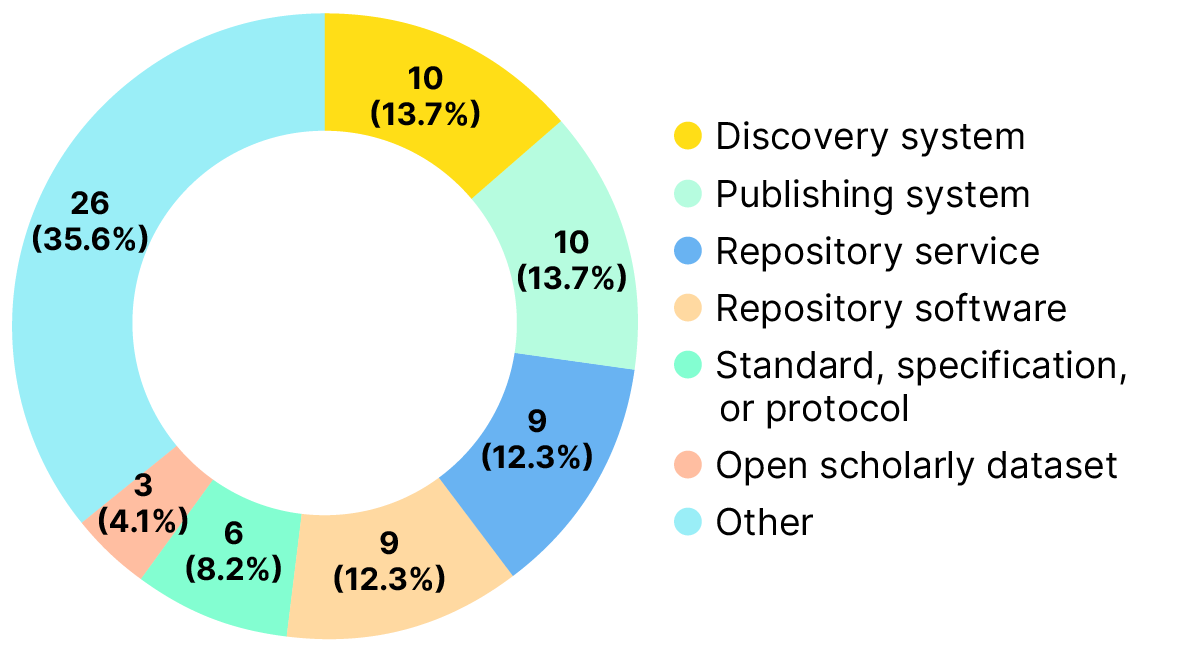
| Solution category | Count |
|---|---|
| Annotations system | 2 |
| Archive information management system | 1 |
| Authoring tool | 2 |
| Digital asset management system | 2 |
| Digital library, collection or exhibit platform | 2 |
| Discovery system | 10 |
| Federated identity or authentication management | 1 |
| Index or directory | 2 |
| Informal scholarly communications | 2 |
| Media viewer/player | 1 |
| Open access or subscription management tool | 1 |
| Open access policy information compilation | 1 |
| Open scholarly dataset | 3 |
| Peer review system | 2 |
| Persistent identifier service | 2 |
| Preservation system | 2 |
| Publishing system | 10 |
| Repository service | 9 |
| Repository software | 9 |
| Research profiling system | 2 |
| Standard, specification, or protocol | 6 |
| Submission system | 1 |
Year of incorporation
OI start dates[4] over time are shown in Figure 2. arXiv (1991) and Érudit (1998) are the longest-lived OIs in the dataset. The timing of important open access declarations (e.g. Budapest Open Access Initiative (2002), Berlin Declaration on Open Access (2003), Bethesda Statement on Open Access Publishing (2003)) and the recognition of repositories as essential scholarly infrastructure (e.g. Lynch, 2003) likely fueled many of the OI developments of the early 2000s. The ten infrastructures started between 2000–2005 include two major repository platforms (DSpace and Fedora) as well as the publishing platform Open Journal Systems. Other key OIs related to open access that were started in this time frame include the Directory of Open Access Journals and Sherpa Services (tools for navigating publisher and funder open access policies and finding open access repositories). Also dating to the early 2000s, Creative Commons sought to simplify and standardize the process of granting permission to reuse creative works, and COUNTER, Crossref, Archival Resource Key, and Journal Article Tag Suite represent important advances in the development of standards and persistent identifiers for use in publishing and repositories. The longevity of these OIs is noteworthy and evidence that they can evolve and endure.
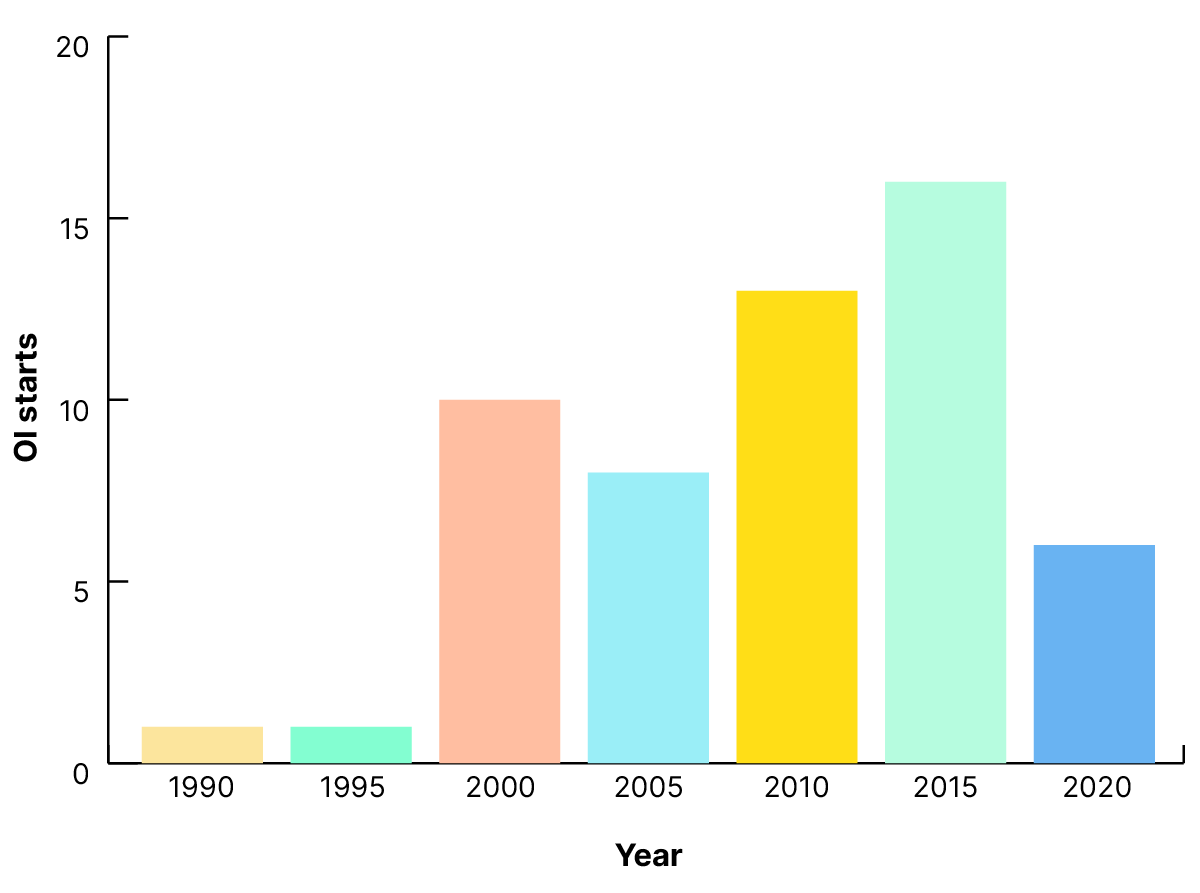
Location of incorporation
The OIs reported in Infra Finder are globally distributed, but the majority are located in North America (32) and Europe (17). This is consistent with findings of Bezuidenhout and Havemann (2020), whose exploration of 242 digital tools for open science found a similar distribution. Four OIs reported no location; these are community-managed OIs that are not formally incorporated or part of a formally incorporated organization.
| Location | Count |
|---|---|
| Belgium | 1 |
| Brazil | 2 |
| Canada | 6 |
| France | 2 |
| Germany | 2 |
| Italy | 1 |
| Malawi | 1 |
| Netherlands | 4 |
| Switzerland | 1 |
| United Kingdom | 6 |
| United States | 26 |
| Uruguay | 1 |
| Not reported | 4 |
Special certifications or statuses
Open infrastructures were asked to report certification or validation through a recognized process or community group. This free text question garnered a very wide range of responses, but it is noteworthy that 12 OIs report participation in the Global Sustainability Coalition for Open Science Services (SCOSS).[5] Four OIs report being ORCID certified, and the three Public Knowledge Project OIs (Open Journal Systems, Open Monograph Press, and Open Preprint System) are Canadian government “Major Science Initiatives”. Other mentions include Guidestar Platinum rating for financial transparency, 501(c)3 equivalency certification, and the security certification SOC 2.
Governance, business form, and finances
The past decade has seen a flurry of interest in community governance, driven by questions about the sustainability and scalability of open infrastructure projects and high-profile examples of OIs being bought out by large commercial entities. The acquisition of such infrastructure by commercial interests raises concerns about the loss of community control over these essential resources (Hart & Adema, 2022). Best practices for community governance of open infrastructure are difficult to define. At a minimum, from the earliest stages of building an OI, community members should be able to understand how (and by whom) decisions are made (Skinner, 2018). As infrastructures mature, they may look to the abundant resources on building and cultivating healthy communities as well as to evaluative frameworks such as the Principles of Open Scholarly Infrastructure (POSI) and the FOREST Framework for guidance. The existence of governance structures and processes should not be taken as a definitive indication that an OI works exclusively in the community interest, follows best practices in its decision-making processes, or is immune to acquisition. However, having a board or other governance body and being able to point to public bylaws and evidence of stakeholder representation in decision making are important prerequisites for community governance. The Infra Finder data show that, while the majority of OIs do have some form of governance structure in place, there is significant room for growth in making governance processes and activities more formal and more transparent.
Community governance
Open infrastructures were asked to indicate whether they have implemented formal or informal governance structures and processes.[6] The overwhelming majority of respondents reported that they have some form of governance structure. Over 50% (n=32) report having formal governance, while around 30% (n=17) describe their governance as ad hoc. The remaining 14% report that they have no form of governance (Figure 3). As evidence of formal governance, 31 respondents provided links to their bylaws. Forty-seven percent (n=27) of OIs responded that they support meaningful governance via actions and events such as meetings, consultations, elections, audits, etc. (Figure 4); all but two of these provided a URL for information on governance activities.
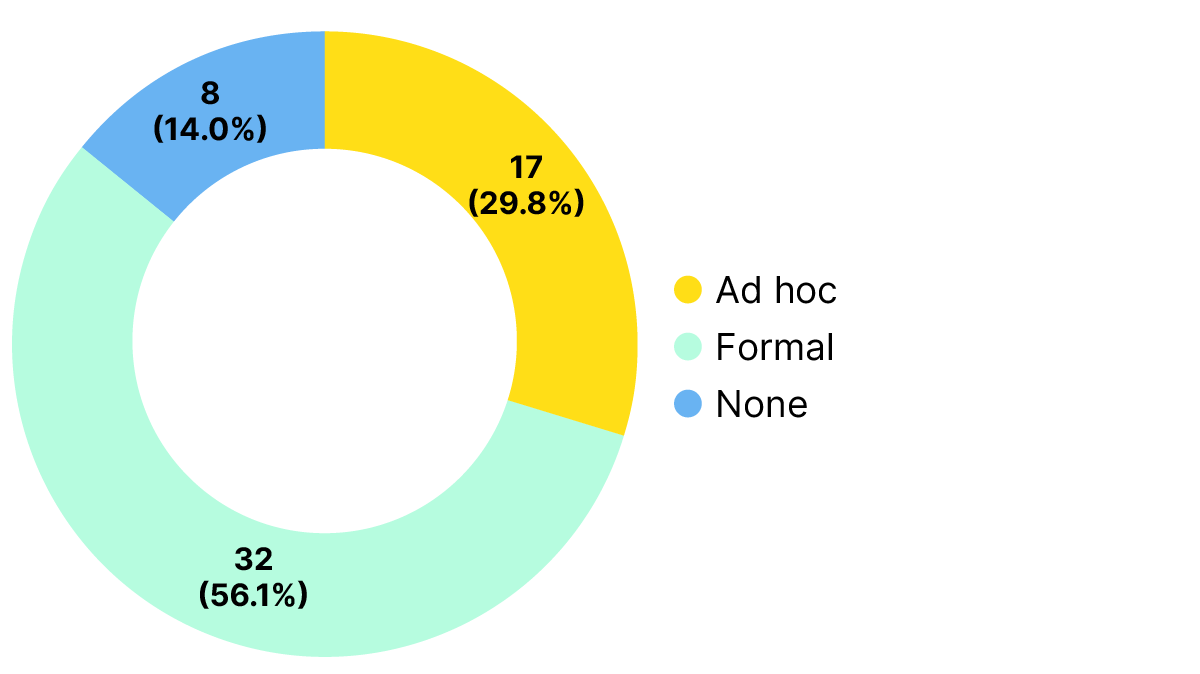
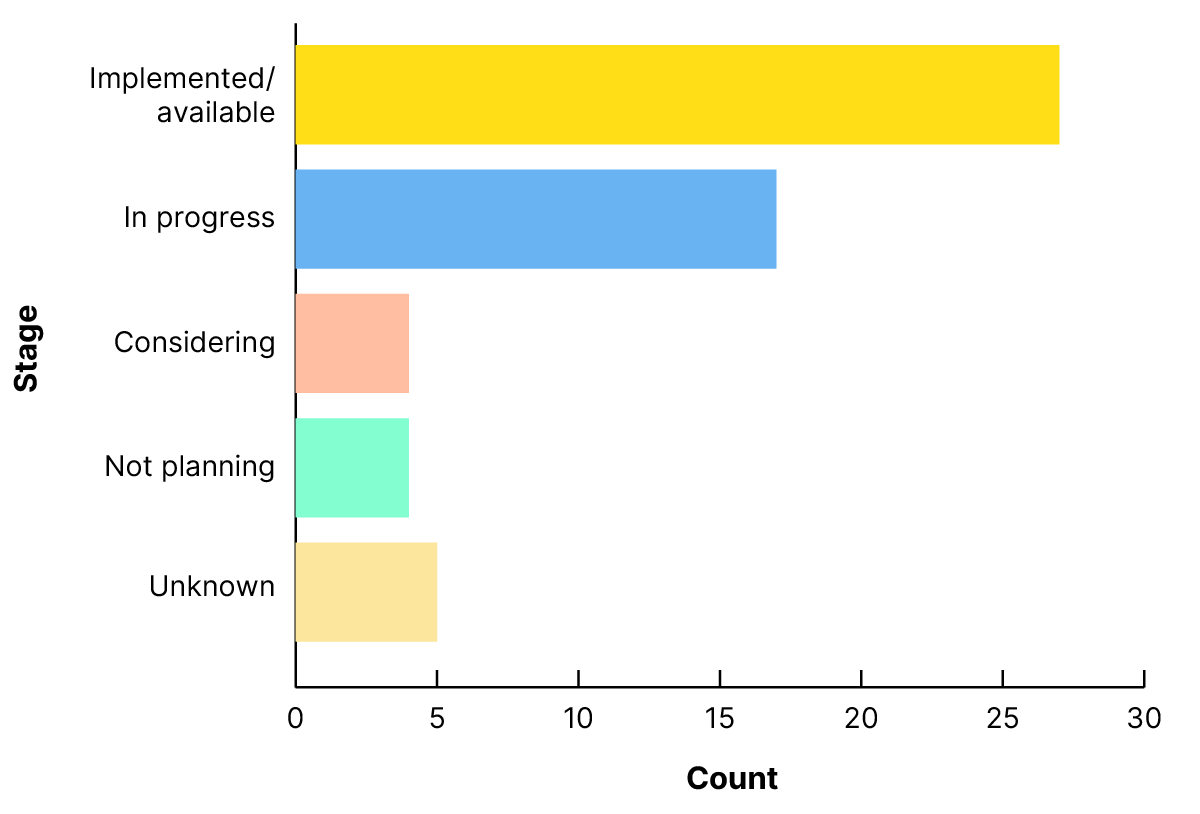
Board structure
Open infrastructures were asked to indicate if they have a governing board. Over 90% (n=52) report some form of governing board. Of those, over half (63%, n=36) reported they have an advisory board or steering committee. Another 17.5% (n=10) reported they use a multi-board governance style, and the remaining 10.5% (n=6) reported they use another governing board structure.
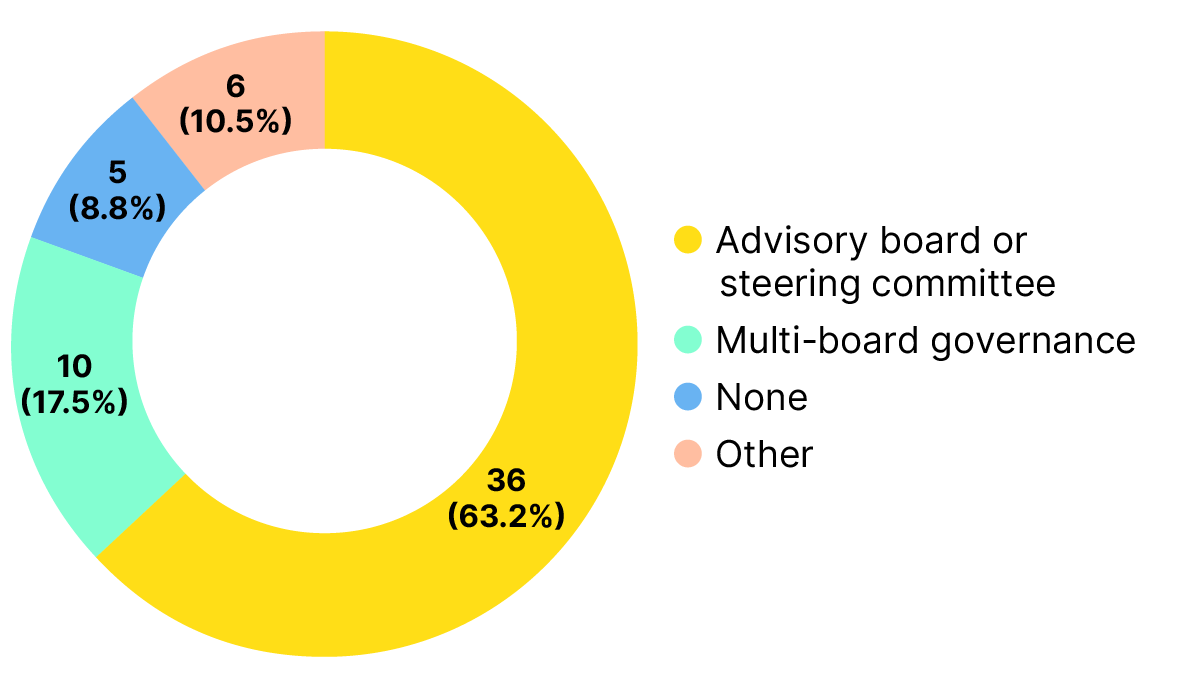
Business form and finances
Business form
Nonprofits of one form or another dominate the dataset; 56% (n=32) are independent or fiscally-sponsored nonprofits, and 26% (n=15) are hosted by an academic institution. As noted in the introduction, our criteria for inclusion in Infra Finder were fairly expansive, allowing for the full range of business forms as long as each OI met at least one of our previously defined criteria for openness.
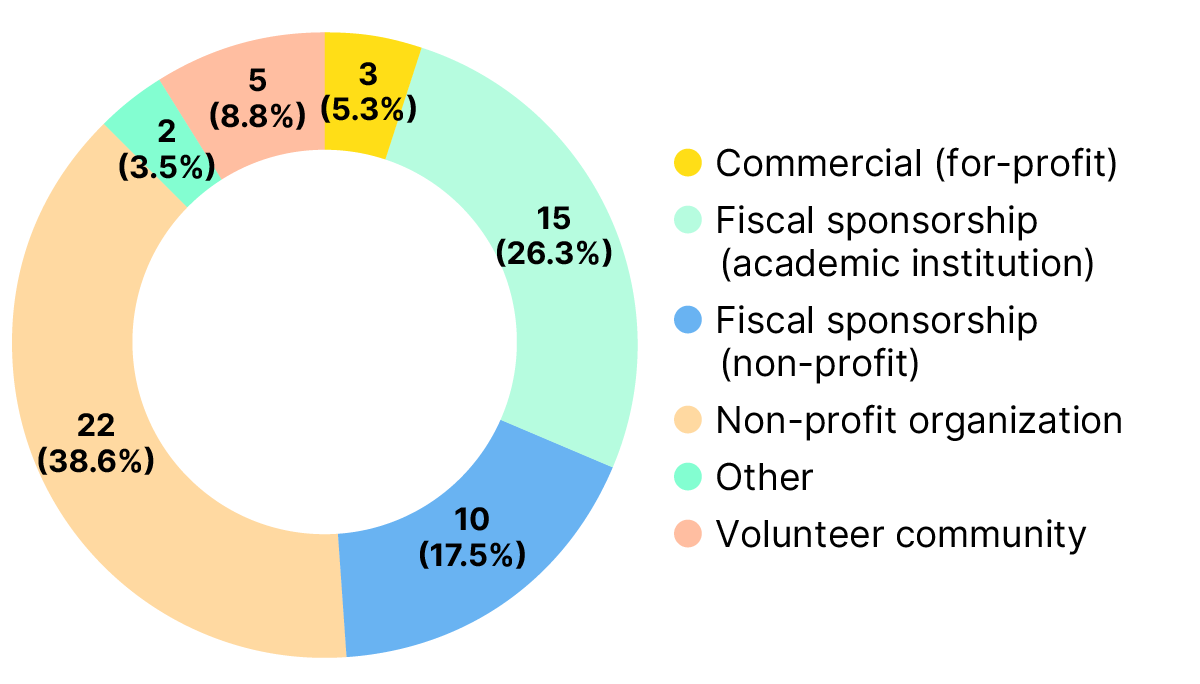
Finances
Nearly half (46%) of OIs report contributions as their primary funding source, followed by other (32%) and programme service revenue (23%). Contributions[7] are the most important source of revenue for independent and fiscally sponsored nonprofits, while programme service revenue[8] is the most important funding source for OIs with an academic institution as their fiscal sponsor. Each of the three commercial OIs reports a different primary source of funding (Figure 7).

Funding needs
OIs had the opportunity to respond to a question asking them to describe their funding needs. Forty-four OIs provided a response, and the responses were coded for general themes. Some responses contained multiple funding needs that connected to more than one theme, but each theme was counted only once per response; the total count of funding needs is 85.
We mapped this coding of articulated funding needs onto the grant categories described in the “State of open infrastructure grant funding” section of this report (Figure 8). These categories are broad and we found additional richness in the OIs’ responses. For example, all of the mentions of DEI work (including translation, fee waivers, and accessibility) are included alongside marketing and communications mentions in the broader grant category “Community”, but it seems important to make visible the importance of DEI in community work. The most frequently mentioned funding need was to develop or maintain necessary service functionality, and was categorized as “operations” (which can also include other aspects of operations, such as user support, administration, etc.). This ongoing maintenance dominated the operations category; the other articulated operations needs were related to hiring, training, and budget.
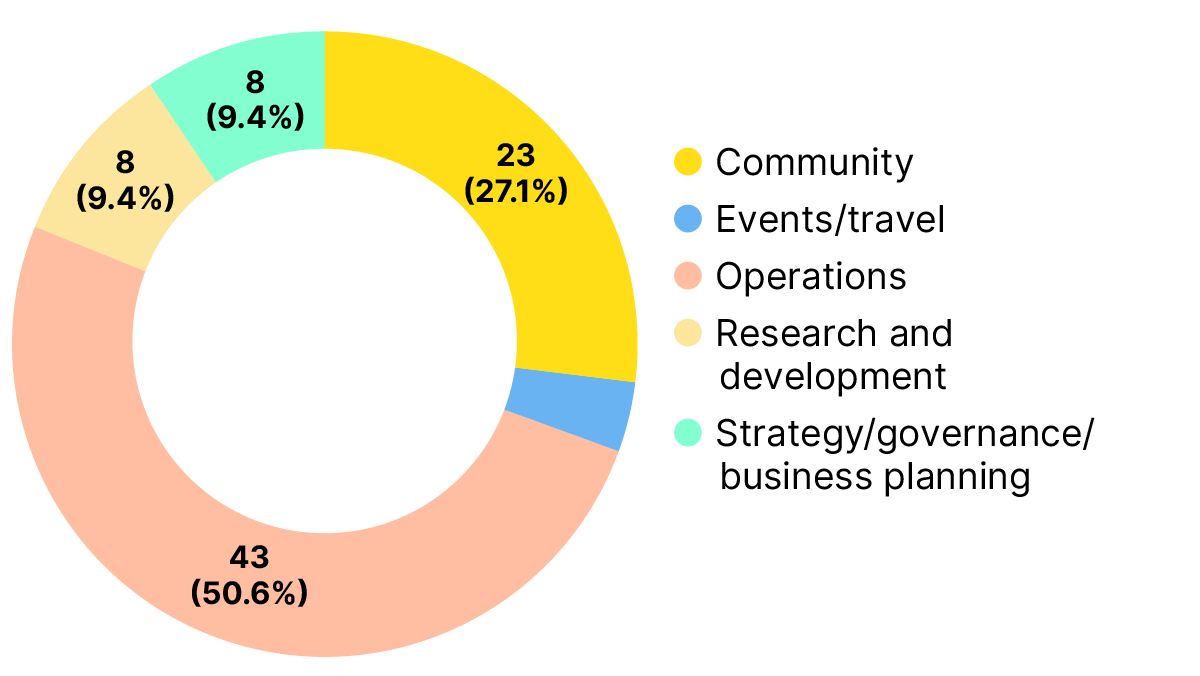
We added an additional layer of categorization to understand the nuances of the funding needs mentioned by providers (Figure 9). Notably, since nearly half (n=21) of responses included mention of critical maintenance or development of functionality, we wanted to clearly distinguish this maintenance need from the work of developing new services or engaging in new projects (n=8, or 18% of OIs). The next largest category was various responses indicating the need to engage with their community of users. Some replies in this category were general (n=10), while others more specifically listed efforts towards diversity, equity, and inclusion (4), and some even more specifically mentioning translation (2), accessibility (3), and fee waivers (4). Operational needs also surfaced, including securing a budget (9), hiring (7), and training (6).
The reported funding needs are diverse, but most of the specific needs articulated in these data involve the sustainability and day to day operations of the OI.
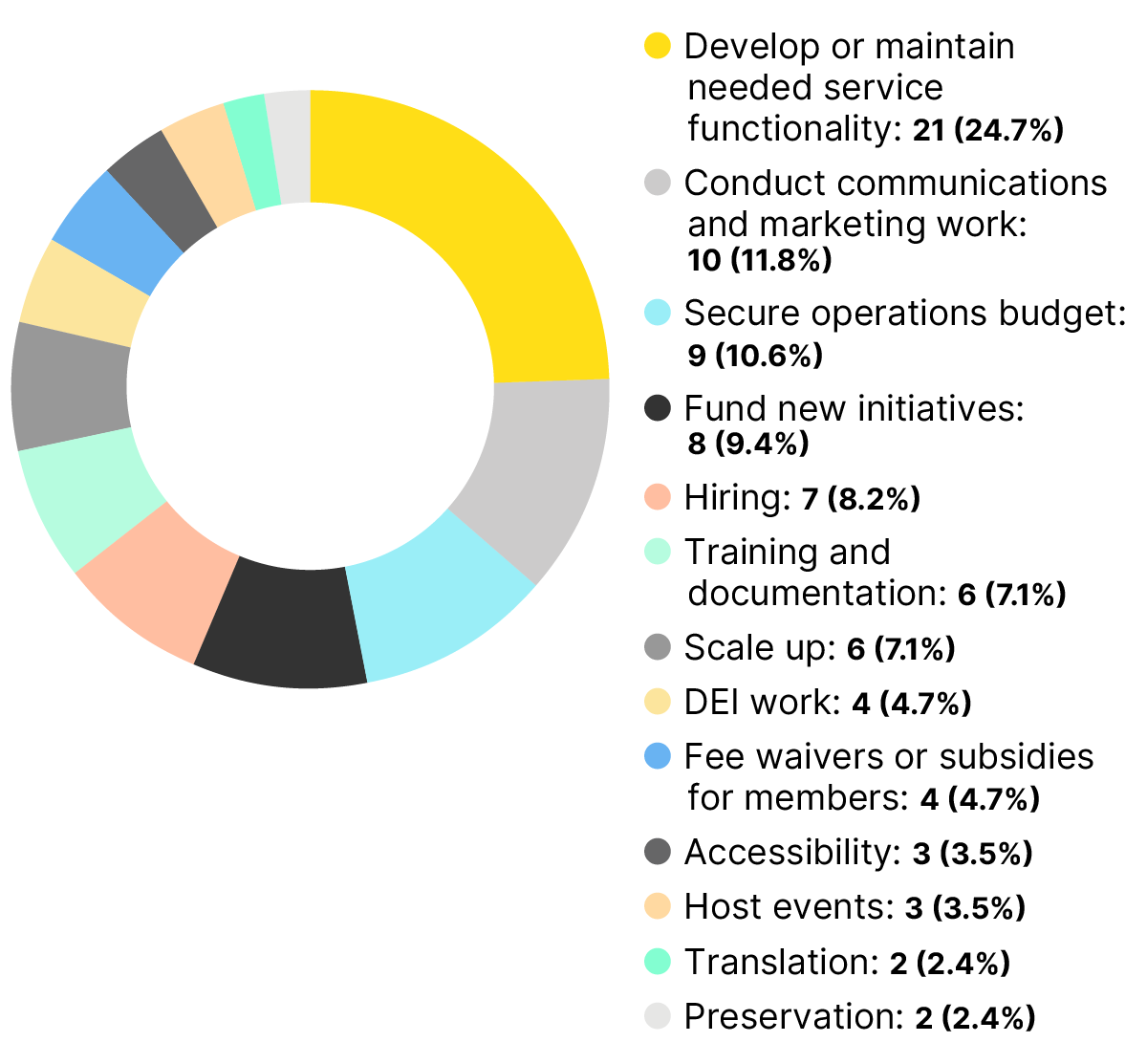
Policy and transparency
Transparency, expressed and communicated through written policies and other documents, encompasses the ways in which an OI represents itself and its business practices to its stakeholders. This may include being upfront about its official business identity and sources of funding, employing consistent and clear pricing terms, and revealing its approach to capturing and protecting user data (e.g. Lippincott & Skinner, 2022). Non-profit organizations that provide more information to their stakeholders perform better across a range of metrics, from fundraising to organizational efficiency (Harris & Neely, 2021). Implementing transparent practices increases an organization's accountability to stakeholders, helping to build trust and providing opportunities for course correction if an organization appears to be out of alignment with its community. Open infrastructures were asked to report on the availability of several types of policies or documents, and their responses are summarized in Figure 10. Maintaining these resources can demonstrate that the community takes seriously its responsibilities towards fostering productive engagement, supporting users from diverse backgrounds and lived experiences, being transparent with respect to privacy and product pricing, and sharing data as openly as possible.
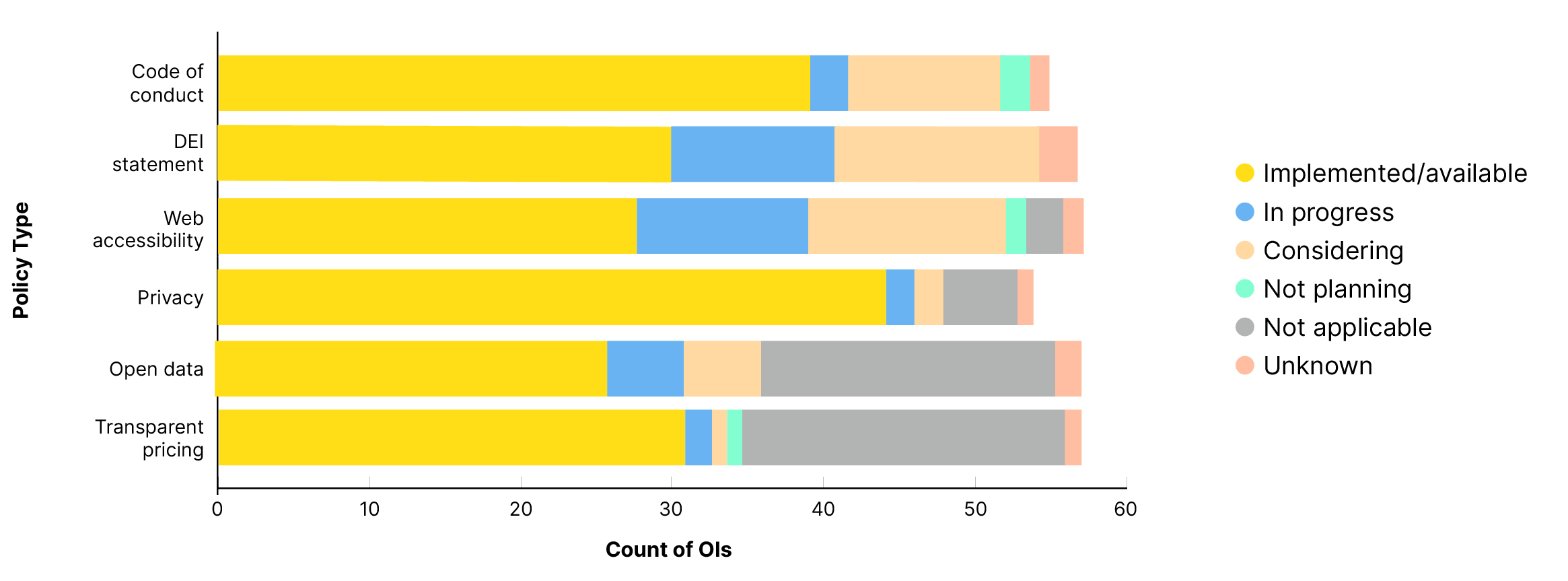
Code of conduct
Seventy percent of respondents (n=40) reported that they have a code of conduct, which is a document that describes the expectations, norms, rules, and responsibilities for individuals participating in physical and digital communities.
Diversity, equity, and inclusion
Fifty-three percent of respondents (n=30) reported having a stated commitment to diversity, equity, and inclusion, supported by clear initiatives, programs, or other activities aimed at measuring and increasing the diversity of users, community members, and other key stakeholders.
Web accessibility
Slightly under half of respondents (47%, n=27) reported that they have a web accessibility statement, which is defined as a public document with information about how they make their web-based tools as usable as possible for anyone. Of the OIs reporting such a policy, ten respond that report that the policy applies to the OI or application itself; ten report that the policy applies to the OI’s website; and six report that it applies to both.
Privacy
Open infrastructures were asked about the availability of a policy regarding the collection and use of user data or personal information. Privacy policies should indicate whether personal information is ever sold, how users can opt out of data collection, and how the OI complies with applicable laws (e.g. GDPR).[9] The majority, 77% (n=44), report an implemented and available privacy policy.
Open data
An open data statement describes an organization’s commitment to the use and availability of their data for users of the OI that allows the data to be accessed to the extent possible. An open data statement is not applicable or unknown for 37% (n=21) of OIs. Among the remaining 36 OIs, 72% (n=26) of OIs report an open data statement, and none report that they are not planning one.
Pricing
Over 50% (n=31) reported that they make their costs and fees transparent and provided a link to their pricing information. Another third of OIs (n=21) indicated that transparent pricing was not applicable to their context. Generally, this response means the tool is completely free to use and therefore does not have pricing information. Looking only at OIs where pricing information is applicable, 86% (n=31 of 36) of OIs report transparent pricing, and all but one support this assertion with a URL for pricing information. Tools that describe themselves as a “publishing system” are most likely to have transparent pricing (90%, n=9), probably because they are more likely than other solution categories to be paid services.
Community engagement
Commitment to community engagement
Community engagement keeps infrastructures accountable to their stakeholders and makes room for their contributions. Governance and policies play an important role and are discussed in previous sections; here we focus on support and avenues for direct, non-governance participation. Respondents were asked how they concretely demonstrate a commitment to community engagement, including indicators such as staff explicitly tasked with community engagement, publicized opportunities for stakeholder involvement, and evidence of community involvement in major decisions or initiatives.
A clear majority (80%, n=46) of respondents reported a commitment to community engagement (Figure 11).
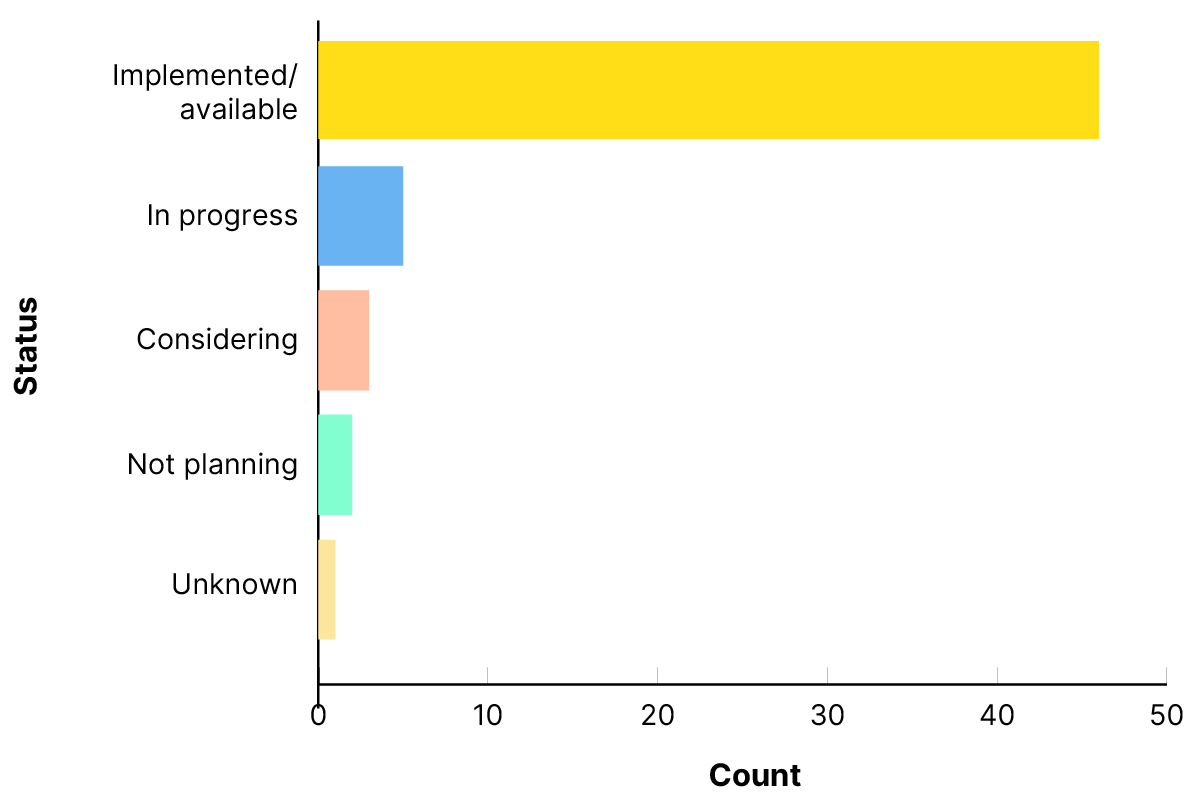
Respondents described a range of specific community engagement activities and strategies, including:
- maintaining a mailing list, discussion forum, or Slack channel;
- having staff roles that include community engagement responsibilities;
- hosting webinars or trainings;
- coordinating user, interest, working, and/or advisory groups;
- hosting regular community calls and/or an annual meeting;
- coordinating a volunteer programme or ambassador network;
- maintaining a presence on social media and blogs;
- conducting user research;
- hosting development sprints or accepting code contributions;
- and participating in conferences.
As in many of the examples above, community engagement often involves an organization pushing out content to keep stakeholders informed, but it should also include ways for stakeholders to meaningfully contribute back into the development of an OI. Contributing code was marginally the most popular response (n=36), followed by contributing funds (n=31) and contributing to working or interest groups (n=31) (Figure 12).
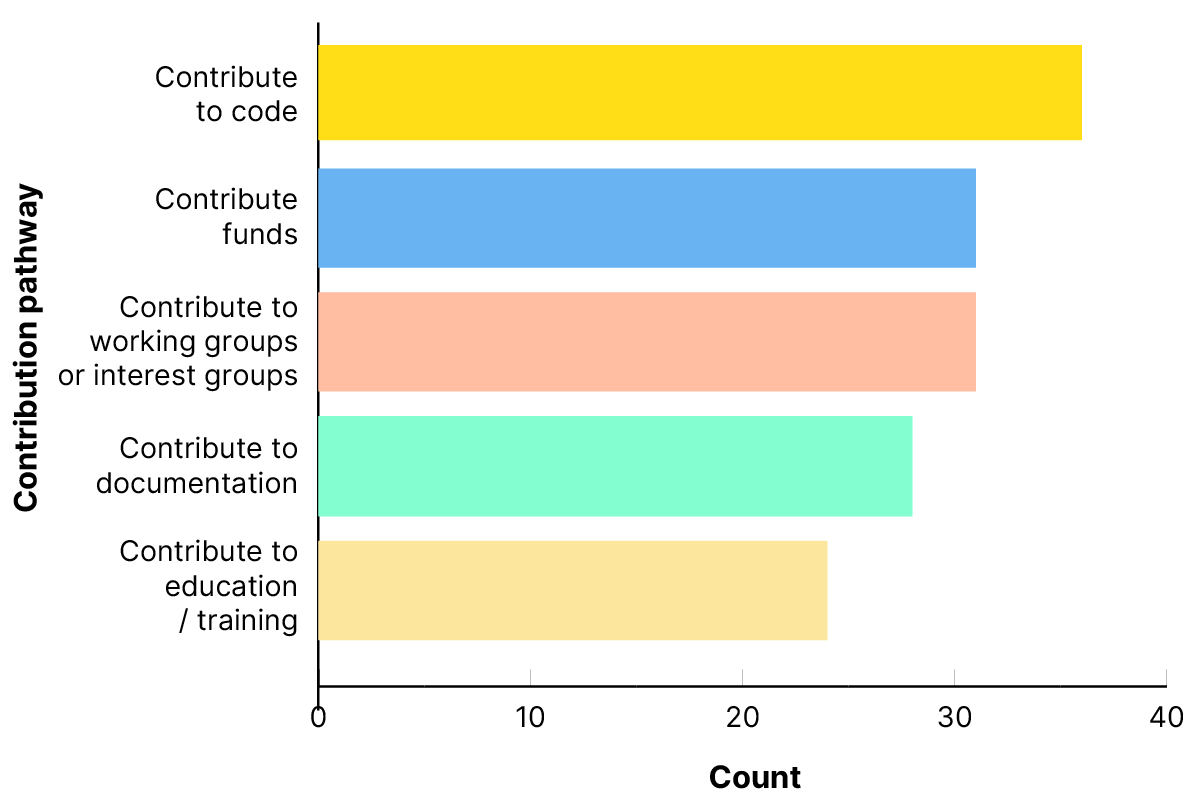
Engagement with values frameworks
Open infrastructures were asked to identify values frameworks (such as Principles for Open Scholarly Infrastructure, the FOREST Framework, etc.) that they have adopted or engaged with. Responses were free text and quite varied, but it is noteworthy that 67% (n=38) of all OIs responded that they had or were planning to engage with at least one values framework. Ten respondents indicated that they have completed a self audit against the Principles of Open Scholarly Infrastructure (POSI) and a further 8 indicated they have been inspired by POSI or are planning a self audit. Respondents also mentioned the FOREST Framework (n=2) and Lyrasis’s It Takes a Village toolkit (Gemill Arp & Forbes, 2018)(n=2). Several respondents referenced the FAIR Data Principles (n=4) and the CARE Principles for Indigenous Data Governance (n=3). Additional but less frequent mentions (one or two occurrences) include the Contributor Covenant (Ehmke, 2014), the Declaration on Research Assessment (DORA, n.d.), FAST principles for preprint peer review (Iborra et al., 2022), Helsinki Initiative on Multilingualism (Federation of Finnish Learned Societies et al., 2019), Joint Statement of Principles of the Coalition for Diversity and Inclusion in Scholarly Communication (C4DISC, 2023), COAR Next Generation Repositories Principles (n.d.), HumetricsHSS values framework (Humane Metrics Initiative (HuMetricsHSS), n.d.), the UN Sustainable Development Goals (United Nations, 2015), and others.
Technical characteristics

Open code repository, open API, and technical documentation
Openness of code and other technical resources is a hallmark of the responding OIs. The majority (86%, n=49) of OIs maintain an open code repository (Figure 13). Sixty-five percent (n=37) of OIs provide an open application programming interface (API). The vast majority (95%, n=54) provide technical documentation.
Open product roadmap
Slightly over half (56%, n=32) of respondents reported that they maintain an open product roadmap, a publicly available document outlining the priorities and progress for product development and in some cases allowing users to submit their own ideas and feedback or vote on proposed features (Figure 13).
Technical documentation
Technical documentation is widely available (95%, n=54) (Figure 13).
Code licensing
Open licensing is common across the OIs, although we lack specific license information for 15 OIs in Infra Finder. GNU General Public License is the most commonly reported. Thirty-nine OIs assign a single license to their code while two assign two licenses and one assigns three (Figure 14).
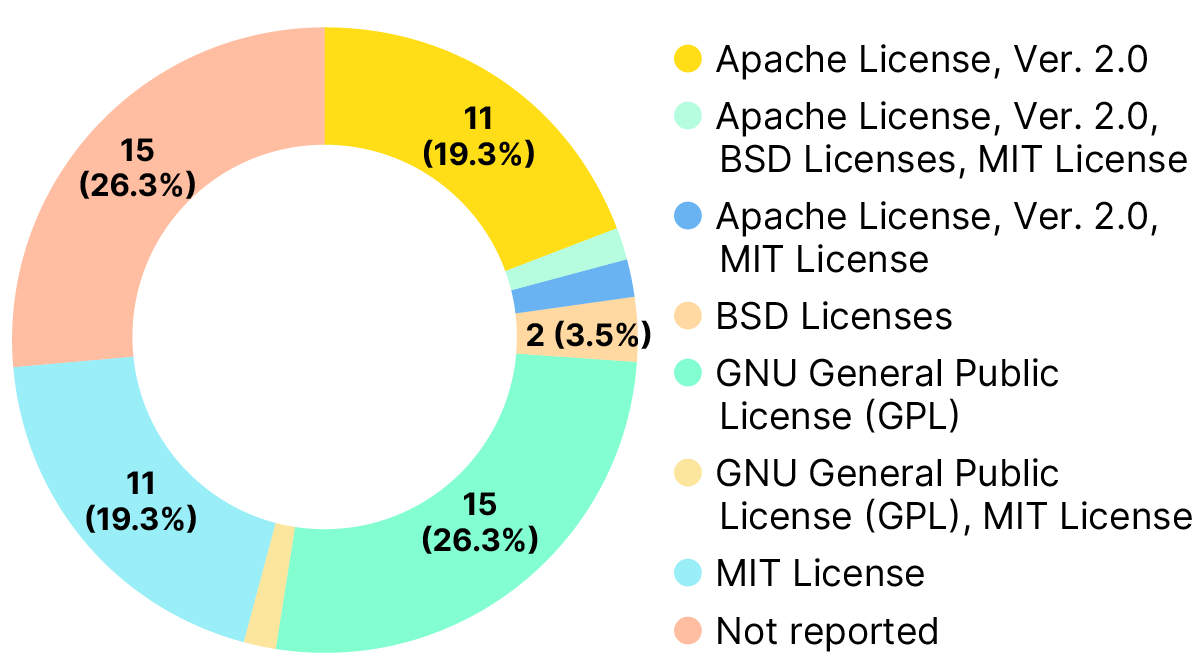
Software as a Service (SaaS) service provider availability
For OIs that might be installed and supported by institutions, the availability of vendor-provided services for open infrastructure can be key in selecting an open solution if the institution does not have dedicated technical staff or infrastructure available locally. Excluding OIs for which hosting is either not applicable or not reported, we found that for the majority (86%, n=17 of 22) some kind of hosting option is available (Figure 15).
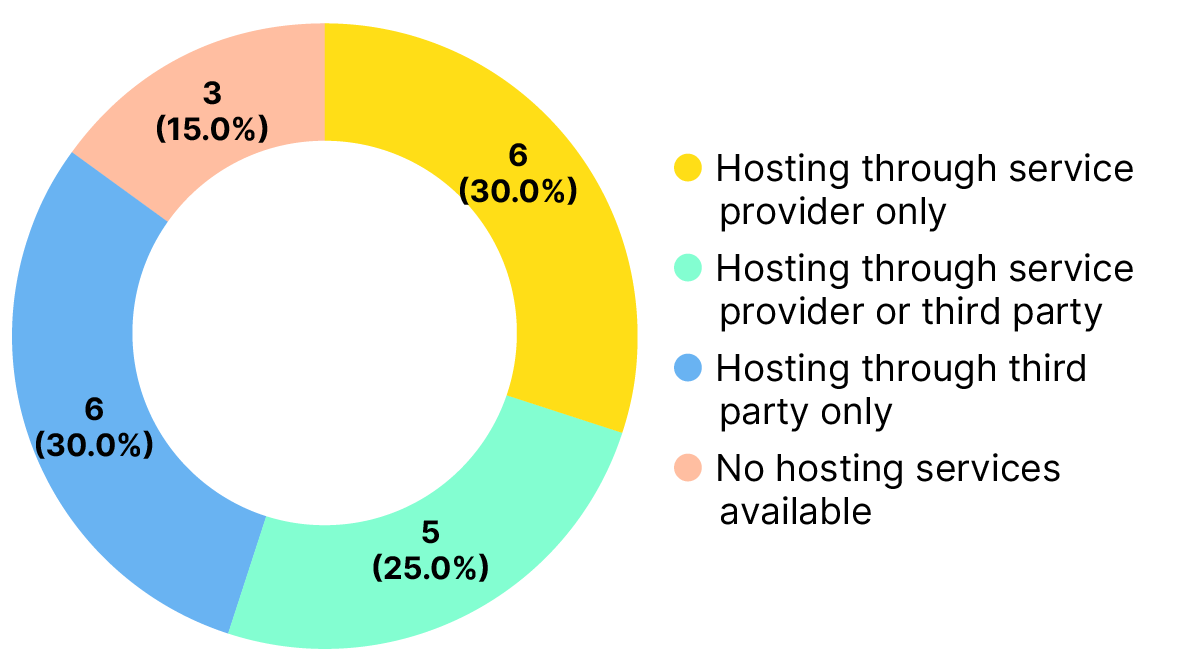
Data availability
The data used for the analyses presented here was exported from Infra Finder on 30 January 2024. Some error corrections have been made to the dataset, but subsequent updates from OIs have not been incorporated. The data (Lippincott et al., 2024) may be downloaded from: https://doi.org/10.5281/zenodo.10835677. Data may also be explored using interactive dashboards: https://investinopen.org/data-room/characteristics-of-open-infrastructure-dashboard.
The Infra Finder intake form used to collect the data reported here (Lippincott et al., 2024) is available online: https://doi.org/10.5281/zenodo.10835682.
References
Berlin Declaration. (2003). Berlin Declaration on Open Access to Knowledge in the Sciences and Humanities. https://openaccess.mpg.de/Berlin-Declaration
Bezuidenhout, L., & Havemann, J. (2021). The varying openness of digital open science tools (9:1292). F1000Research. https://doi.org/10.12688/f1000research.26615.2
Bilder, G., Lin, J., & Neylon, C. (2020). The Principles of Open Scholarly Infrastructure (v1.1, 2023). The Principles of Open Scholarly Infrastructure. https://doi.org/10.24343/C34W2H
Brown, P. O., Cabell, D., Chakravarti, A., Cohen, B., Delamothe, T., Eisen, M., Grivell, L., Guédon, J.-C., Hawley, R. S., Johnson, R. K., & others. (2003). Bethesda statement on open access publishing. http://nrs.harvard.edu/urn-3:HUL.InstRepos:4725199
Budapest Open Access Initiative. (2002). https://www.budapestopenaccessinitiative.org/read/
Carroll, S. R., Garba, I., Figueroa-Rodríguez, O. L., Holbrook, J., Lovett, R., Materechera, S., Parsons, M., Raseroka, K., Rodriguez-Lonebear, D., Rowe, R., Sara, R., Walker, J. D., Anderson, J., & Hudson, M. (2020). The CARE Principles for Indigenous Data Governance. Data Science Journal, 19, 43. https://doi.org/10.5334/dsj-2020-043
Coalition for Diversity and Inclusion in Scholarly Communications (C4DISC). (2023). Joint Statement of Principles. Coalition for Diversity and Inclusion in Scholarly Communications. https://c4disc.org/joint-statement-of-principles/
Collister, L., Tsang, E., & Wu, C. (2024). Infra Finder: A new tool to enhance transparency, discoverability, and trust in open infrastructure. International Digital Curation Conference (IDCC), Edinburgh, Scotland. [Preprint] https://doi.org/10.5281/zenodo.10913249
Confederation of Open Access Repositories (COAR). (n.d.). COAR Next Generation Repositories: Principles. https://ngr.coar-repositories.org/principles/
DORA. (n.d.). San Francisco Declaration on Research Assessment. DORA. https://sfdora.org/read/
Ehmke, C. A. (2014). Contributor Covenant: A Code of Conduct for Open Source and Other Digital Commons Communities. https://www.contributor-covenant.org/
Federation of Finnish Learned Societies, Information, T. C. F. P., Publishing, T. F. A. F. S., Universities Norway, & European Network For Research Evaluation In The Social Sciences And The Humanities. (2019). Helsinki Initiative on Multilingualism in Scholarly Communication. 621757 Bytes. https://doi.org/10.6084/M9.FIGSHARE.7887059
Gemill Arp, L., & Forbes, M. (2018). It Takes a Village: Open Source Software Sustainability—A Guidebook for Programs Serving Cultural and Scientific Heritage. Lyrasis. https://itav.lyrasis.org/guidebook/
Harris, E. E., & Neely, D. (2021). Determinants and Consequences of Nonprofit Transparency. Journal of Accounting, Auditing & Finance, 36(1), 195-220. https://doi.org/10.1177/0148558X18814134
Hart, P., & Adema, J. (2022). Introduction. In P. Hart, J. Adema, & COPIM (Eds.), Towards Better Practices for the Community Governance of Open Infrastructures (1st ed.). Copim. https://doi.org/10.21428/785a6451.57d211e7
Humane Metrics Initiative (HuMetricsHSS). (n.d.). HuMetricsHSS Values Framework. https://humetricshss.org/our-work/values/
Iborra, Sandra F., et al. “FAST Principles for Preprint Feedback.” (2022). OSF Preprints, 13 Jan. 2022. https://doi.org/10.31219/osf.io/9wdcq
Lippincott, S., & Skinner, K. (2022). FOREST Framework for Values-Driven Scholarly Communication. https://doi.org/10.5281/zenodo.6557301
Lippincott, S., Skinner, K., Steinhart, G., & Wu, C. (2024). Intake form for Infra Finder - 2023 (Version 1). Zenodo. https://doi.org/10.5281/zenodo.10835682
Lippincott, S., Collister, L., Wu, C., & Steinhart, G. (2024). Data for: Characteristics of Selected Open Infrastructures, 2024 State of Open Infrastructure Report [Data set]. Zenodo. https://doi.org/10.5281/zenodo.10835677
Lynch, C. A. (2003). Institutional Repositories: Essential Infrastructure For Scholarship In The Digital Age. Portal: Libraries and the Academy, 3(2), 327–336. https://doi.org/10.1353/pla.2003.0039
Skinner, Katherine. (2018). Community Cultivation: A Field Guide. Educopia. https://educopia.org/wp-content/uploads/2018/11/CommunityCultivationFieldGuide.pdf
United Nations. (2015). Transforming our world: The 2030 Agenda for Sustainable Development. United Nations: New York, NY, USA. https://sdgs.un.org/publications/transforming-our-world-2030-agenda-sustainable-development-17981
Wilkinson, M. D., Dumontier, M., Aalbersberg, Ij. J., Appleton, G., Axton, M., Baak, A., Blomberg, N., Boiten, J.-W., da Silva Santos, L. B., Bourne, P. E., & others. (2016). The FAIR Guiding Principles for scientific data management and stewardship. Scientific Data, 3(1), 1–9. https://doi.org/10.1038/sdata.2016.18
Glossary of terms
- Board structure: The way in which a service or provider’s governing board is structured.
- Advisory board or steering committee. Usually composed of a small number of experts and senior figures from allied stakeholder organizations, advisory boards are convened to provide input on decision making and strategic direction, either at the individual, ad hoc level, or through regular board meetings. This means that advisory boards are often external to the project, or at least not composed by active participants within the project itself, and so are called upon for direction and accountability.[10]
- Multi-board governance. Distributed model involving multiple boards with differing areas and levels of responsibility [allowing] oversight of discrete areas within a community-driven organization.[11]
- None. The OI does not have a formal governing or advisory board.
- Other. The OI has an alternate form of formal governing board.
- Business form: The service's legal business structure or formal aims.
- Commercial (for-profit): The OI or provider operates with the primary goal of making a profit.
- Fiscal sponsorship (academic institution): The OI is hosted by an academic institution that provides administrative, financial, and legal support.
- Fiscal sponsorship (non-profit): The OI is hosted by a non-profit organization that provides administrative, financial, and legal support.
- Non-profit organization: The OI or provider is an independently incorporated nonprofit.
- Volunteer community: The OI is run by a group of uncompensated individuals and is not formally incorporated.
- Other: Business form other than one of the above.
- Service: A product or infrastructure component. In some cases, the service may be the same as a provider. Examples of services include Open Journal Systems (OJS), DSpace, Figshare, Kotahi, and arXiv.
- Service provider: A provider is a formal or informal organization responsible for running a service. Examples of providers include The Public Knowledge Project (PKP), Lyrasis, Digital Science, Coko Foundation, and arXiv.
- Solution category: The function(s) that a service is primarily designed to serve.
- Annotations system: A tool that allows scholars to mark up and comment on digital works, either individually or collaboratively.
- Archive information management system: An application used to organize, control, and manage information about archival collections.
- Authoring tool: A tool or platform that facilitates the creation of documents destined for print or digital publication. These tools may provide real-time editing, built-in templates, version control, and support for formats like LaTeX, making them useful for academic and scientific writing.
- Digital asset management system: An application used to store, organize, manage, and share digital files and assets.
- Digital library, collection, or exhibit platform: An application used to share collections of digital objects and create media rich online exhibits.
- Discovery system: A tool that facilitates search and retrieval of scholarly content.
- Federated identity or authentication management: A secure system that enables user authorization, authentication, and digital identity management.
- Format conversion tool or service: A tool that supports the transformation of digital files or metadata from one format to another.
- Index or directory: A curated list of resources relevant to a certain audience.
- Informal scholarly communications: Digital tools that facilitate activities that occur outside of formal journal publication, such as communication on social media, listservs, or through other digital platforms.
- Media viewer/player: A tool that allows users to play digital audiovisual content.
- Open access policy information compilation: A curated list of open access policy information.
- Open scholarly dataset: An open dataset intended to support scholarly research.
- Peer review system: A tool that facilitates the pre- or post-publication review of manuscripts.
- Persistent identifier service: A service that maintains a persistent identifier registry and associated tools and services.
- Personal information management system: A platform or software that allows individuals to collect, organize, and store digital objects.
- Preservation system: A system that facilitates long-term, secure storage of digital objects.
- Publishing system: A platform that facilitates digital publishing workflows.
- Repository service: A hosted digital platform that makes information resources available online.
- Repository software: A software that can be used by a community to ingest, manage, preserve, and share digital content.
- Research profiling system: Research profiling systems, also known as Research Information Management Systems (RIMS) or Current Research Information Systems (CRIS), “collect and store structured data about faculty research and scholarly activities for one institution, with the intention of repurposing the information in a variety of ways”.
- Standard, specification, or protocol: A set of community-accepted rules used by two or more parties to interact or exchange information.
- Submissions system: A digital platform or software used by academic journals and publishers to streamline the process of authors submitting their research papers for peer review and publication consideration. They facilitate the efficient handling of manuscripts, including submission, peer review management, and editorial workflow tracking.
- Other: OI does not align with any of the categories above.
- Technical documentation: Technical user documentation meaningfully describes the process for users to install, configure, maintain, and troubleshoot the code for running a service. In the case of those OIs not reliant on client installs, documentation should meaningfully describe how users perform tasks on the platform to utilize the service. Documentation may include installation guides, tutorials, manuals, FAQs, etc.
- Technology readiness level:[12] The service’s fitness for broad adoption.
- Experimental proof of concept: The OI is under development and not yet available to users.
- Technology validated in relevant environment: The OI has a minimum viable product but is not yet implemented in production.
- System prototype demonstration in operational environment: The OI is implemented in a single instance.
- System complete and qualified: The OI is production ready, fully featured, and in limited use within the scholarly community.
- Actual system proven in operational environment: The OI is production ready, fully featured, and widely in use within the scholarly community
Feedback
- https://infrafinder.investinopen.org/
- https://infrafinder.investinopen.org/
- Discovery system is the solution category most often associated with additional categories (five of 10 occurrences, associated with Persistent identifier service, Preservation system, Research profiling system, and Repository software), followed by Repository software (four of 10 occurrences, associated with Discovery system, Repository service, Preservation system, Publishing system, and Digital library, collection or exhibit platform).
- Start dates are self reported, not independently verified, and it is possible respondents interpret start date differently (i.e. formal incorporation of an organization, vs the initial development of a project).
- https://scoss.org/
- Note that in the case of a fiscally sponsored OI, the answer may apply to the umbrella organization rather than the OI itself.
- The amount of money that the organization received from donors and grantmakers during the year. For US-based non-profit organizations, IRS Form 990, Part I, line 8.
- The amount of money that the organization received from charging fees or selling goods or services related to its mission or programmes during the year. For US-based non-profit organizations, IRS Form 990, Part I, line 9.
- https://gdpr-info.eu/
- https://copim.pubpub.org/pub/wp4-report-exploring-models-for-community-governance#advisory-board-steering-committee
- https://copim.pubpub.org/pub/wp4-report-exploring-models-for-community-governance#multi-board-governance-structures
- Technology readiness levels used in Infra Finder are adapted from the framework developed by the Horizon 2020 project: https://ec.europa.eu/research/participants/data/ref/h2020/wp/2014_2015/annexes/h2020-wp1415-annex-g-trl_en.pdf
Find us on